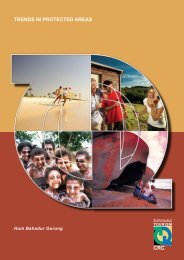icolls - Sustainable Tourism CRC
icolls - Sustainable Tourism CRC
icolls - Sustainable Tourism CRC
You also want an ePaper? Increase the reach of your titles
YUMPU automatically turns print PDFs into web optimized ePapers that Google loves.
ECOLOGY, THREATS AND MANAGEMENT OPTIONS FOR SMALL ESTUARIES AND ICOLLS<br />
in non-tidal running water ecosystems (Vannote et al. 1980; Thorp & Delong 1994). Furthermore, there has been<br />
considerable debate regarding the general applicability of the existing models to a wide range of running waters,<br />
with numerous empirical examinations of each of these models, across a wide range of lotic environments,<br />
having yielded equivocal results (Hamilton, Lewis & Sippel 1992; Bunn, Davies & Winning 2003).<br />
River Continuum Concept (RCC) Vannote et al. 1980.<br />
Headwater stream food webs heavily reliant on allochthonous<br />
(riparian) organic matter. Reliance on allochthonous carbon<br />
reduces with distance downstream.<br />
Riverine Productivity Model (RPM) Thorp &<br />
Delong 1994. Food webs supported by instream<br />
primary production by algae and<br />
aquatic macrophytes.<br />
Flood Pulse Concept<br />
(FPC) Junk et al. 1989.<br />
Riverine food web<br />
supported by floodplain<br />
organic matter inputs<br />
during floods.<br />
Marine Pulse Concept<br />
(MPC).<br />
Marine inputs when<br />
ICOLL mouth is open.<br />
Ocean<br />
Sea<br />
Figure 1: Conceptual model of carbon sources and pathways in an ICOLL<br />
Source<br />
We propose that some, if not all, of these models are useful in conceptualising how small ICOLLs might<br />
function. Furthermore, given that ICOLLs comprise a unique series of conditions, we add an additional and new<br />
conceptual component (Marine Pulse Concept (MPC)) to incorporate the marine subsidies that ICOLLs receive<br />
when connected to the ocean. The MPC is based largely on the FPC, which highlights the role of infrequent yet<br />
substantial pulsed contributions of carbon into an aquatic ecosystem (Junk, Bayley & Sparks 1989). Whilst the<br />
FPC focuses on lateral connectivity and floodplain carbon, the MPC focuses on marine carbon sources<br />
(including algae – phytoplankton and macroalgae like seaweeds – and animals) that enter ICOLLs during periods<br />
of entrance opening (Figure 1).<br />
Given their small catchment sizes and intermittent connectance with the ocean, ICOLLs are likely to receive<br />
varying quantities and qualities of organic matter from terrestrial, freshwater and marine sources (Nikolova<br />
Eddins 2001; Figure 1). As a result, ICOLLs represent ideal systems in which to test (and modify) these existing<br />
models of energy processing in aquatic food webs. In this chapter we report findings from work aimed at testing<br />
the applicability of these four conceptual models of carbon pathways in a range of small ICOLLs in northern<br />
New South Wales, Australia. Specifically, we aimed to develop a better conceptual understanding of the role of<br />
marine connectance in sustaining ICOLL community structure and function from a food web perspective.<br />
Furthermore, in light of the importance of small ICOLLs to recreational and commercial fisheries, we aimed to<br />
assess the importance of various sources of carbon to consumer diets, particularly the abundant commercially<br />
important species that often reside in these small coastal systems. We aimed to gain a broader understanding of<br />
ICOLL functioning such that predictions of system response to artificial opening events might be facilitated.<br />
15











